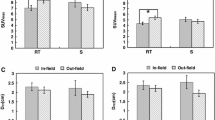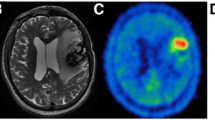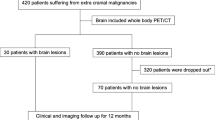Abstract.
Stereotactic radiosurgery (SRS) using the Leksell gamma knife promotes acute and chronic local changes in glucose metabolism. We have been able to find very few papers on Medline on the subject of assessment of metastases by 2-[18F]fluoro-2-deoxy-D-glucose positron emission tomography (FDG PET) after SRS. The aim of this work was to specify the additional value of FDG PET, in comparison with magnetic resonance imaging (MRI), in differentiating SRS-induced radionecrosis from viable brain metastasis in a clinical setting. Fifty-seven metastases in 25 patients were treated by SRS. An average of 33 weeks later, all the patients underwent FDG PET. At the same time (SD=2 weeks) all the patients underwent MRI. The sensitivity, specificity and accuracy of both FDG PET and MRI examinations were calculated with reference to clinical and radiological follow-up or biopsies. The additional value derived from use of FDG PET after MRI was assessed and progression-free survival rates were compared. The difference in progression-free survival rates between the negative and positive subgroups was significant (P=0.0005) for MRI and even more so (P<0.00001) for FDG PET. Sensitivity, specificity and accuracy were 75% (6/8), 93.9% (46/49) and 91.2% (52/57) for FDG PET, and 100% (8/8), 65.3% (32/49) and 70.2% (40/57) for MRI. In the subgroup of patients with positive or non-diagnostic MRI, the probability of presence of a viable tumour was only 32% (8/25). This probability increased to 100% (5/5) when subsequent FDG PET was positive and decreased to 11.1% (2/18) when FDG PET was negative. The frequency of a viable neoplasm was significantly different (P=0.001) in the FDG PET negative and positive subgroups. MRI and FDG PET both have an important predictive value for persistent viable metastases after treatment by SRS. Neither sensitive but non-specific MRI nor specific but insensitive FDG PET is reliable on its own. While FDG PET significantly improved the diagnostic accuracy in the subgroup of patients with positive and non-diagnostic MRI, it provided no additional value in the MRI-negative subgroup.
Similar content being viewed by others
Author information
Authors and Affiliations
Additional information
Electronic Publication
Rights and permissions
About this article
Cite this article
Bělohlávek, O., Šimonová, G., Kantorová, I. et al. Brain metastases after stereotactic radiosurgery using the Leksell gamma knife: can FDG PET help to differentiate radionecrosis from tumour progression?. Eur J Nucl Med 30, 96–100 (2003). https://doi.org/10.1007/s00259-002-1011-2
Received:
Accepted:
Issue Date:
DOI: https://doi.org/10.1007/s00259-002-1011-2




